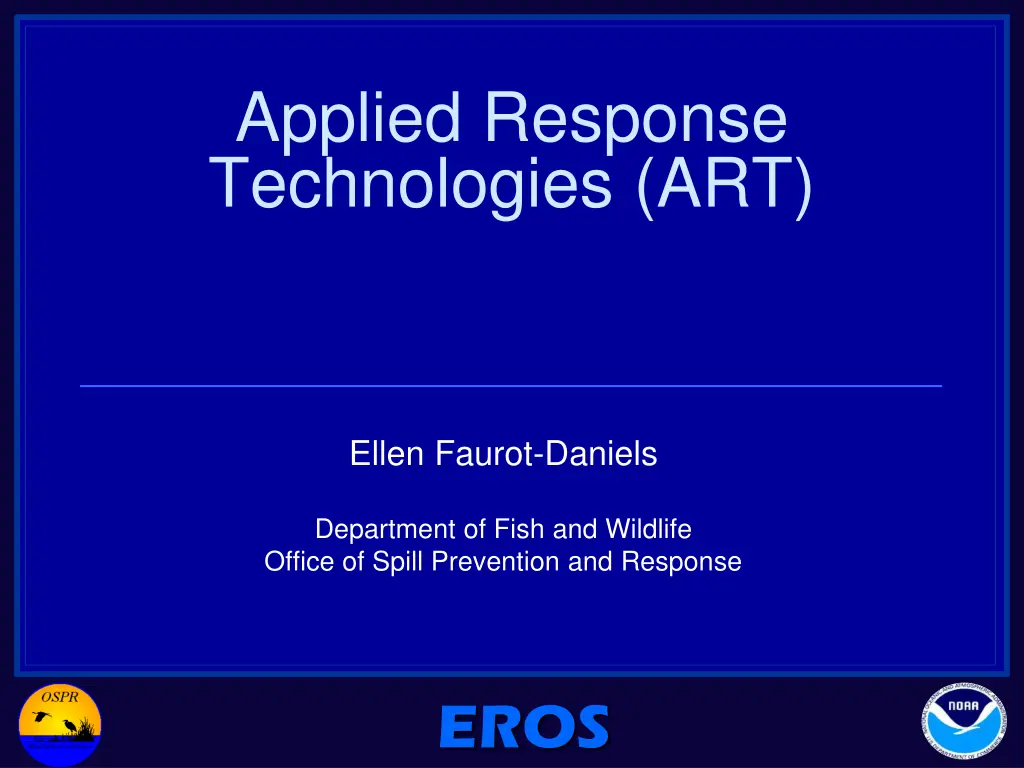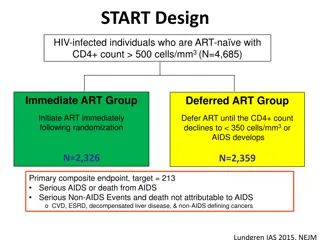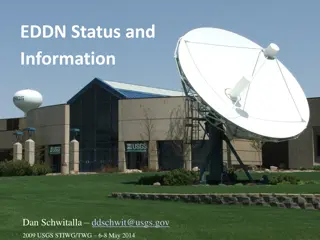
Understanding Applied Response Technologies in Oil Spill Response
"Explore the utilization of Applied Response Technologies (ART) in oil spill response, including the definition, objectives, options, and considerations for employing ART. Discover the role of ART in minimizing environmental impacts and response trade-offs. Learn about ART use in California and the regulatory framework governing its application."
Download Presentation

Please find below an Image/Link to download the presentation.
The content on the website is provided AS IS for your information and personal use only. It may not be sold, licensed, or shared on other websites without obtaining consent from the author. If you encounter any issues during the download, it is possible that the publisher has removed the file from their server.
You are allowed to download the files provided on this website for personal or commercial use, subject to the condition that they are used lawfully. All files are the property of their respective owners.
The content on the website is provided AS IS for your information and personal use only. It may not be sold, licensed, or shared on other websites without obtaining consent from the author.
E N D
Presentation Transcript
Applied Response Technologies (ART) Ellen Faurot-Daniels Department of Fish and Wildlife Office of Spill Prevention and Response EROS
Objectives for Presentation Use of ART in spill response ART background and legislation Oil Spill Cleanup Agents (OSCAs) California Dispersant Plan California In-Situ Burning Policy Questions and Discussion EROS
Definition of ART: Response technologies, other than mechanical cleanup, that can be employed to address an oil spill. Includes: Oil Spill Cleanup Agents (OSCAs) Examples: Dispersants, other chemical countermeasures (including bioremediants), non-chemical sorbents In-situ burning (ISB) EROS
Oil Spill Response Options Our goal is to have all available tools ready to use in an emergency situation. Can include: - Dispersants and other OSCAs - Skimmers - Containment and sorbent boom - In-Situ burning Can sometimes use more than one at a time. EROS
Realities of Spill Response Why Consider ARTs? Once oil is spilled, there will be injury to the environment No amount of cleanup will remove all oil from the environment. EROS
Realities, continued If environmental injury cannot be avoided, response efforts must shift to minimizing the injury. We evaluate short-term vs. long-term impacts to habitats and species at risk, and shape response priorities accordingly. EROS
Realities, continued All decisions associated with spill response have inherent trade-offs. - Mechanical - Dispersants - In-Situ Burning - No Response EROS
ART Use in California The OSPR Administrator has the State s authority over all response technologies to address an on-water oil spill. The federal Regional Response Team (RRT) must approve the use of all ARTs to address an oil spill within Federal jurisdiction. EROS
Definition of an OSCA: A chemical, or any other substance, used for removing, dispersing, or otherwise clean-up oil or any residual products of petroleum in, or on, any waters of the State. An exemption can be approved if the manufacturer can demonstrate that the OSCA is not toxic and does not pose a hazard to the aquatic environment. EROS
State Licensing of OSCAs The OSPR Administrator has authority over the licensing and use of all OSCAs in state waters (marine and fresh) All OSCAs must be licensed by the Administrator before use (or reviewed and given an exemption). Except: Experimental use of unlicensed products allowed in some limited circumstances. EROS
Federal Listing of OSCAs Address only oil spill chemical and biological countermeasures. Product must be listed on the US EPA Product Schedule, or granted an EPA exemption (sorbents always given exemption). Product Schedule OSCAs are registered, not licensed. Any OSCA on the federal Product Schedule can be used by the FOSC for spills on federal waters, but need RRT approval Recommend use of CA licensed products and/or ones that have had received further study and review) Other tools: Selection Guide and ARTES EROS
Federal Planning and Response National Response Team: National planning & coordination (products: NCP and NCP Product Schedule) Policy and program guidance Regional Response Team (RRT IX): Regional planning, coordination of preparedness and response actions, including use of applied response technologies (products: RCP and ACPs). Membership: Federal agencies and State representatives. Standing RRT and Incident-Specific RRT. EROS
Chemical Countermeasures Emulsion-treating agents Vaso-elasticizers (e.g., elasticity modifying agents, gelling agents, solidifiers) Shoreline cleaners Herding agents Dispersants Bioremediants EROS
Emulsion Treating Agents Emulsions are formed when energy is applied to oil and water. It is difficult to disperse, burn or mechanically recover oil once stable emulsions have formed. The oil industry uses emulsion breakers in field production, but these products not generally available off-the-shelf. Some studies by Alaska Clean Seas indicated emulsion treatment could work on up to 70% emulsified oil and still burn. More research needed into emulsion formation at sea. No emulsion breakers currently licensed for use in California. EROS
Elasticity Modifiers Products bond with oil to form a semi-solid or solid mass; oil will not re-sheen; spilled oil more cohesive, easier to pick up Available in either liquid or dry, granular form; some dry forms packaged in self-contained boom, socks or pillows State and RRT policies allow use of only self-contained forms on open water (not same as loose within otherwise contained area) State pre-approval for some elasticity modifiers/solidifiers in self- contained form (boom, sock, pillow), but no RRT pre-approval yet Liquid/loose forms can be hard to dose properly for large spills Liquid/loose forms good for ship grounding to control loss of fuel in a tank, but can ruin the vessel EROS
Shoreline Cleaning Agents Usually have a surfactant base similar to dispersants. Optimally, will lift and float oil, not disperse it into water column. Can be used alone but typically used in combination with warm-water wash. Present studies suggest that shoreline cleaning agents may be used to clean marsh plants. Presently, two shoreline cleaners licensed in California: Cytosol and Accell. Method of use & type of cleaner is substrate-dependent. EROS
Ways to Enhance the Action of Shoreline Cleaning Agents Low-Pressure Washing High-Pressure Washing Passive flooding EROS
Bioremediants Use of microbes (native or added), nutrient supplementation, and/or oxygen supplementation to enhance natural biodegradation of oil Slow action time, so typically considered as final step to remove residual oil in sensitive or inaccessible areas, and after danger of re-oiling has passed Often not necessary if native microbes, nutrients and oxygen are available (Kathleen will give a presentation on natural biodegradation study following a CA spill) Extensively planned for, but not used, during DWH EROS
Dispersants Surface active agents (surfactants) with hydrophilic and hydrophobic components Used to reduce oil-water interfacial tension Effectiveness varies with weathering, salinity and emulsification Requires addition of energy EROS
Dispersants, continued Present formulations of dispersants less toxic than spilled crude oil Present toxicity concerns are with dispersed oil (dispersant + oil), not dispersants alone A dispersant use decision is a determination of response and environmental trade-offs In general, the lighter the crude, the easier it is to disperse. However, no benefit to use of dispersants on spills of gasoline, diesel, or jet fuel EROS
How Dispersants Work -- A Pictorial The dispersant is applied to the water surface. Molecules of the dispersant attach to the oil, causing it to break into droplets. Wave action and turbulence move the oil-dispersant mixture from the water surface into the water column EROS
Dispersant-enhanced Bioremediation Breaking surface oil slicks into small droplets greatly increases the surface area of the oil, and makes the droplets more available to bacteria and other micro-organisms that use it as food source However, dissolved components of oil (PAHs) can cross cell membranes, fish gills, etc. , and may create new routes of exposure and toxicity Other contaminants in the oil (e.g., metals) must be broken down as well Ultimate break-down of hydrocarbons is into CO2 and H2O EROS
Policy Development RRT IX tasked each of the 6 area committees to recommend a policy for dispersant use in federal waters (3 200 nm from shore), within each Area Committee s zone of operation. Zone recommendations from each Area Committee forwarded to USCG and RRT for their approval. With modifications as necessary, RRT approved all the dispersant-use plans and they became a part of the RCP and NCP. EROS
Dispersant Use Zones Pre-Approval Zones Federal marine waters 3-200 nm from the coastline or island shoreline except: Waters part of a National Marine Sanctuary, or within three miles of the CA/Mexico border( (These may change pending results of ESA Section 7 consultations for use of dispersants in offshore pre-approval zones). RRT Incident-Specific Approval Required Zones and Uses State marine waters (0 3 nm miles from shore) Waters part of a National Marine Sanctuary Waters within three miles of the CA/Mexico border Marine waters one mile from anadromous fish streams during times of emigration and immigration. Subsea use or use at surface for more than 5 days EROS
California Dispersant Plan Single document for the evaluation of dispersant use in California FOSC checklists and flow charts for both zone and use types Appendices for ease of referencing EROS
Embedded Plans and Protocols Special Monitoring of Applied Response Technologies (SMART) Conducted in real time, generally by Pacific Strike Team Looks for presence of dispersed oil; does not give oil concentrations. Wildlife Spotting Protocols Seafood Safety Public Communications Short and Long-Term Monitoring for Environmental Concentrations: Dispersed Oil Monitoring Plan (DOMP) Goal: Determine where and when monitoring should take place. Data can be used for fishery closures, for NRDA and for validating assumptions made during the NEBA process for dispersant pre- approval EROS
Dispersant Delivery Platforms Information regarding all dispersant resources available in or to California (dispersant stockpiles, application platforms) is in the California Dispersant Plan EROS
Dispersants: During and After DWH Both aerial spraying and subsea injection used Aerial spraying on surface waters April 22 - May 26: About 682,808 gallons Corexit 9527A and 9500A May 27 - July 19: About 293,436 gallons Corexit 9500A Sub-Total: 976,244 Subsea injection at the source May 9 - May 15: About 15,151 gallons of Corexit 9500A (2 tests) May 15 - July 19: About 771,000 gallons of Corexit 9500A Sub-Total: 786,151 Grand Total: 1,762,395 EROS
DWH Dispersant Use: Fate and Effects Oil Budget (August 4, 2010 numbers): Directly recovered from wellhead: 17% Mechanically skimmed: 3% Evaporated or dissolved: Naturally dispersed: 25% 16% Chemically dispersed: In-situ burn: 8% 5% Residual: 26% EROS
DWH Dispersant Fate and Effects, continued Dispersants were applied consistent with all policies FOSC directed the response and use of dispersants, not the RP Extensive monitoring for dispersant effectiveness, impacts on human health, and impacts on water and wildlife were employed Additional EPA dispersant components analysis validated initial toxicity effects data; FDA analysis indicated components commonly used in foods, cosmetics and OTC medications, and many are GRAS Dispersant use (surface and subsea) greatly reduced shoreline and wildlife impacts Seafood safely samples indicated uptake of oil by organisms did not reach levels of concern for human consumption Even with the extensive loading of dispersants in this response, the dispersants behaved as expected and there was a determination of net environmental benefit for their use EROS
What Did California Learn from DWH Dispersant Use? Subsea use, and surface use of dispersants for more than 5 days, had not been previously evaluated as part of NEBA Subsea use and use of surface for >5 days will need RRT incident-specific approval Rest of NEBA assumptions still seem to apply Biological Assessment for ESA Section 7 submitted to NMFS and USFWS, currently under review Once ESA consultations complete, will update CDP EROS
Other ARTs In Situ Burning EROS
In-Situ Burning EROS
IN-SITU BURNING Removal of oil from the environment by burning it in-place. Advantages over other response methods: - Quickly removes large quantities of spilled oil - Only small amounts of residue are left to clean up - Volatile organics are destroyed - Combustion products readily dispersed within 500 meters of burn (for burns over water) EROS
In-Situ Burning, continued Major health concern of burning is the particulate matter concentration in soot plume. - Can cause significant health risk if inhaled - PM10 (particulate matter of 10 micrometer diameter) levels may exceed state standards in soot plume for several miles beyond the burn site. If oil not burned, it still presents health risk from volatile light-ends. - BTEX components (benzene, toluene, ethylbenzene, xylene), known carcinogens & teratogens EROS
In-Situ Burning, continued In-situ burning is limited by: - oil thickness - weathering of oil - emulsion formation - oceanographic conditions - availability of specialized fire-retardant containment boom (none currently available in CA; closest is in WA state, about 24 hrs away) EROS
Mechanics of In-Situ Burning Need to first boom the oil to maintain a minimum burn thickness EROS
Mechanics of Burning, continued Need to be able to ignite the oil once boomed. Helitorch shown here EROS
Mechanics of Burning, continued Need to be able to control the burn and stop it if necessary. Can do this by having the boom boats pull forward faster on the boom, which drowns the fire). EROS
Mechanics of Burning, continued When burn is done, need to clean-up oil residue. EROS
California In-situ Burn Policy General Scope Coast is divided into designated zones: - Offshore waters 35 nm or more from coastline Pre-Approval to FOSC FOSC discretion to determine whether use is appropriate. - Offshore waters 0-35 nm from coastline Quick Approval Specific distances from shore with off-shore or parallel-to-shore winds. Case-by-Case All other areas and wind conditions. EROS There are no designated prohibition zones.
Quick Approval Zones If prevailing winds off-shore/parallel to shore North Coast AQMD Mendocino AQMD Bay Area AQMD N. Sonoma AQMD Monterey Bay Unified San Luis Obispo County Santa Barbara County Ventura County APCD South Coast AQMD San Diego AQMD .5 miles from shore .5 miles from shore 5 miles from shore .5 miles from shore No QA zones 3 miles from shore 3 miles from shore .5 miles from shore 8 miles from shore .5 miles from shore EROS
Summary of Main Points It is important that all tools be in the tool box at the time of an oil spill incident. All response options have inherent trade-offs associated with their use. All OSCAs must be federal listed and state licensed to gain approval for use during spill response. OSCA approval is gained by request of the Unified Command, and through approval of the Administrator of the OSPR and the RRT. EROS
Summary of Main Points, continued Dispersant use can be approved through the Pre- approval or Incident-Specific RRT Approval Processes; the process used depends on the location of spill. In-Situ burning can be authorized through Pre- approval ( 35 nmi from shore) or through the Quick Approval or Case-by-Case processes for waters <35 nm from shore, or for inland areas. EROS
Questions? Ellen Faurot-Daniels ellen.faurot-daniels@wildlife.ca.gov (831)649-2888 (office) 831-233-0723 (cell) www.dfg.ca.gov/ospr EROS






















